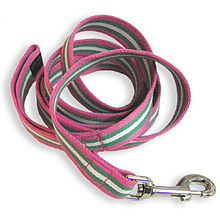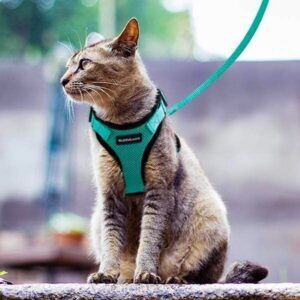Do you take your cat for a jaunt with harness and leash? Have you learned how to teach your cat to walk on a leash? The following information would have been valuable for me when we returned to Alaska from the Lower 48.
We drove the Alcan with all our belongings loaded in a small trailer and the camper on our truck. We knew we would find good camp spots along the way, and we wanted to allow our two Kodiak alley cats, Uptight Cat and Loose Cat, out for some exercise when we stopped for the night.
Let’s See If It Works
No one told us that it takes some time and patience to teach a cat about harness and leash. So we just assumed the furry family members would learn with no problem. So, we purchased harnesses and leashes. One day shortly before we readied for departure, we decided to try out the new equipment on Uptight and Loose. We received a big surprise.
and leashes. One day shortly before we readied for departure, we decided to try out the new equipment on Uptight and Loose. We received a big surprise.
When we put the harness on Uptight Cat, Mr. Houdini wiggled and squirmed until he got out of the harness. Loose Cat’s technique proved simpler. When we put the harness on him, he just laid down. I could have dragged him anywhere.
We quickly scrapped the harness and leash idea, as we departed for Alaska soon. Instead, when we camped at night, we just let the cats out of the trailer and they did a little exploring and hunting. The didn’t go far away, and returned promptly at mealtime. Whew!
If we’d known it took some training and practice, we could have made a go of the harness and leash, but the cats would have none of it without that interval to train. Now I know better.
Therefore, to save any of you from a similar experience, read on for information on how to leash-train your cat.
Before Training Starts
Make sure kitty’s vaccinations are all up-to-date. Have flea and tick medication on hand if you need it in your area.
If your cat does not have a microchip, you might consider getting one for him just in case he gets free and disappears.
Now, let’s proceed with the training process.
Step One
Find the right harness. You might want to start out with the thinner, light-weight figure-eight harness that loops around the cat’s neck and shoulders.
These lighter ones may prove better for getting your kitty used to having something on his body. Later, you may wish to change.
The lighter harnesses offer far less security than the wider, vest-style versions which fasten with Velcro around the back and chest.
 With a traditional leather harness, you need to be able to fit two fingers under the straps. Then you will have the correct size. With the Velcro wrap vests, they fit more tightly, so you will only be able to fit one finger underneath. Perhaps if Uptight Cat could have had one of these harnesses, he would not have escaped, as he did from the leather one.
With a traditional leather harness, you need to be able to fit two fingers under the straps. Then you will have the correct size. With the Velcro wrap vests, they fit more tightly, so you will only be able to fit one finger underneath. Perhaps if Uptight Cat could have had one of these harnesses, he would not have escaped, as he did from the leather one.
Do not use just a collar, as your cat could easily slip out of it. Also, a collar pulled tight against a cat’s neck can damage the feline’s trachea, making it hard for him to swallow. The harness distributes the cat’s energy between its shoulder, belly, and chest and therefore will not harm him.
It’s best to tackle such training with a young cat, as they may accept the lessons faster and easier.
Step Two
Find an appropriate leash. Choose a lightweight leash, four to six feet long, as these fit the ideal for leash training. Don’t start with a retractable leash or a longer one.
Step Three
Get kitty used to the harness and leash. Put it somewhere close to a spot where he spends time, such as by his food bowl.
All of this training, by the way, needs to be accompanied by a liberal disbursement of treats, so kitty will respond more willingly.
Put the harness on the cat, accompanied by giving treats, and let him wear it for a short time. If he shows signs of discomfort or anxiety, such as pulling away or freezing in place, take it off and try again later. Remember to give him that reward.
shows signs of discomfort or anxiety, such as pulling away or freezing in place, take it off and try again later. Remember to give him that reward.
At first, start with just a few minutes in the harness, and gradually add more time, until kitty becomes comfortable wearing this new gear.
Once the cat accepts the harness, add the leash. Indoors, let the cat drag it around to get used to having it attached. If the dragging leash frightens the cat, hold it up and allow kitty to move about freely.
Don’t forget to encourage with treats. Praise your furry friend continuously when he does well. Keep the experience a positive one. If it takes months, you will get good practice in patience while allowing your cat to get used to this newfangled contraption.
Here is an interesting YouTube video on training a cat to walk on a leash. It includes some extra tips that you might find useful.
When the cat accepts the harness and leash, walk him around the house with it on. Let the cat take the lead, and follow where he wants to go. Coax kitty to walk, using treats or toys. Don’t pull the cat by the leash; however, you can give a gentle tug to direct his attention. Don’t forget to give him praise and treats.
Step Four
Once kitty becomes used to harness and leash inside, it’s time for the first outdoor experience. For your first walk, choose a quiet spot, perhaps a fenced yard, for this first outing.
Rather than taking the chance that when you open the door, your cat will bolt for freedom, pick him up and carry him outside.
 Let kitty decide where to go. Reward often with treats. If the cat shows the desire to explore the area, let him lead — never force him. If he wants to lie in the warm sun, let him do so.
Let kitty decide where to go. Reward often with treats. If the cat shows the desire to explore the area, let him lead — never force him. If he wants to lie in the warm sun, let him do so.
Once your kitty will walk with you freely on the leash, be sure to stay away from an area that might startle him, such as a busy road or barking dogs. You don’t want to create a situation that will cause your cat to be afraid of going on walks in the future.
Keep the leash loose, so there is no sign of tension in the cat. Try to walk behind and to the side of your little hiker.
First outings should feature plenty of rewards, and should start the moment you first get cat-with-harness outside. Keep the first experience short — One reference said no longer than six minutes. You don’t want to cause the cat to become anxious.
Once kitty becomes comfortable with short walks, you can extend the time and go further from home. Just let the cat decide if he feels comfortable or perhaps feels threatened and needs to return to your house.
Patience does it here. You must allow kitty to adjust to this new experience as he becomes comfortable with it.
Over time, kitty will become accustomed to walking with harness and leash, and you can share fun walks together that will enrich kitty’s life and your own, creating a closer bond.
References I used for this post:
be.chewy.com/cat-walking-101-train-cat-walk-leash/
thesprucepets.com/how-to-leash-train-cats-551823
aarp.org/home-family/friends-family/info-2021/leash-training-cat.html
animalwised.com/how-to-train-a-cat-to-walk-on-a-leash-2771.html


I can’t even imagine getting any of our 4 cats in a harness. 1 won’t even let us pick her up. Getting them to the vet is a challenge!
Great article.
Your cats are all outside cats, right? Sounds like one of them is nearly feral. I’m sure they are a challenge when you need to do a vet visit. Even a pampered indoor cat is not happy to go there. Yes, it’s best to know your cat before starting something like harness training.